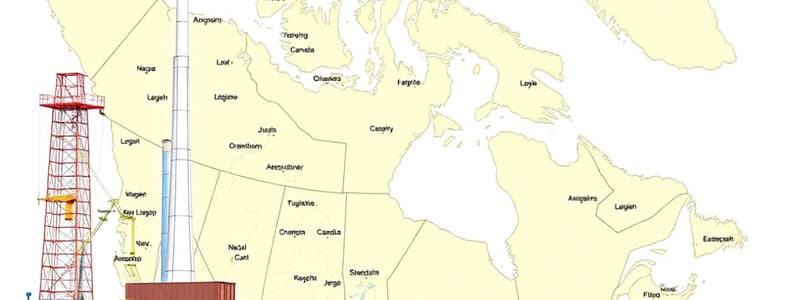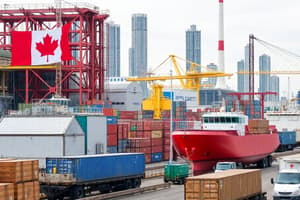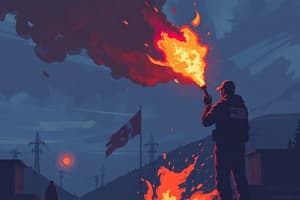Podcast
Questions and Answers
What are primary, secondary, tertiary, and quaternary industries? Give local examples of each.
What are primary, secondary, tertiary, and quaternary industries? Give local examples of each.
Primary: industries that take raw materials from the environment. Secondary: processing of primary industry products into finished goods. Tertiary: provides a wide range of services that support primary and secondary industries. Quaternary: teachers, accountants, computer programmers- people that process ideas rather than products.
Which level of industry employs the most people?
Which level of industry employs the most people?
Tertiary
Why did Newfoundland's fisheries collapse (4 reasons)?
Why did Newfoundland's fisheries collapse (4 reasons)?
Overfishing, improved technologies, uncontrolled foreign fishing, destructive fishing practices
Explain the Tragedy of the Commons. The tragedy of the commons occurs when several individuals share a limited resource. It arises when multiple individuals who share the resource, act independently out of their own self-interest, ultimately depleting the shared limited resource even when it is clear that it is not in anyone’s long-term interest. Individuals use a commonly available but limited resource solely on the basis of individual need. At first they are rewarded for using it; eventually they get diminishing returns which causes them to intensify their efforts. Eventually, the resource is either significantly depleted, eroded, or entirely used up.
Explain the Tragedy of the Commons. The tragedy of the commons occurs when several individuals share a limited resource. It arises when multiple individuals who share the resource, act independently out of their own self-interest, ultimately depleting the shared limited resource even when it is clear that it is not in anyone’s long-term interest. Individuals use a commonly available but limited resource solely on the basis of individual need. At first they are rewarded for using it; eventually they get diminishing returns which causes them to intensify their efforts. Eventually, the resource is either significantly depleted, eroded, or entirely used up.
Which is Canada's largest forest region?
Which is Canada's largest forest region?
Which is the most productive forest region in Canada?
Which is the most productive forest region in Canada?
What are commercial and non-commercial forests? commercial forests are harvested for profit and non-commercial are forests where trees are not suitable for harvest or grow too far apart to be profitable for harvest
What are commercial and non-commercial forests? commercial forests are harvested for profit and non-commercial are forests where trees are not suitable for harvest or grow too far apart to be profitable for harvest
What are the 3 main types of logging? Explain the advantages and disadvantages of each.
Clear-cutting: advantages: fast, uniform regrowth disadvantages: soil erosion, loss of habitat for plants and animals, regrowth may not be successful
Shelterwood: advantages: will regenerate naturally, forests will not be uniform disadvantages: more costly than clear cutting, visible damage to forest
Selective cutting: advantages: least disruptive, not as visible, doesn't destroy the ecosystem, forest regenerates quickly and naturally disadvantages: extremely expensive
What are the 3 main types of logging? Explain the advantages and disadvantages of each.
Clear-cutting: advantages: fast, uniform regrowth disadvantages: soil erosion, loss of habitat for plants and animals, regrowth may not be successful
Shelterwood: advantages: will regenerate naturally, forests will not be uniform disadvantages: more costly than clear cutting, visible damage to forest
Selective cutting: advantages: least disruptive, not as visible, doesn't destroy the ecosystem, forest regenerates quickly and naturally disadvantages: extremely expensive
Flashcards
Primary Industries
Primary Industries
Industries that take raw materials from the environment.
Secondary Industries
Secondary Industries
Processing of primary industry products into finished goods.
Tertiary Industries
Tertiary Industries
Provides a wide range of services that support primary and secondary industries.
Quaternary Industries
Quaternary Industries
Signup and view all the flashcards
What were the four main reasons for the Newfoundland Fisheries Collapse?
What were the four main reasons for the Newfoundland Fisheries Collapse?
Signup and view all the flashcards
Tragedy of the Commons
Tragedy of the Commons
Signup and view all the flashcards
Canada's Largest Forest Region
Canada's Largest Forest Region
Signup and view all the flashcards
Most Productive Forest Region in Canada
Most Productive Forest Region in Canada
Signup and view all the flashcards
Commercial Forests
Commercial Forests
Signup and view all the flashcards
Non-commercial Forests
Non-commercial Forests
Signup and view all the flashcards
Clear-cutting
Clear-cutting
Signup and view all the flashcards
Shelterwood
Shelterwood
Signup and view all the flashcards
Selective Cutting
Selective Cutting
Signup and view all the flashcards
Pangea
Pangea
Signup and view all the flashcards
What causes the movement of tectonic plates?
What causes the movement of tectonic plates?
Signup and view all the flashcards
Crust
Crust
Signup and view all the flashcards
Mantle
Mantle
Signup and view all the flashcards
Outer Core
Outer Core
Signup and view all the flashcards
Inner Core
Inner Core
Signup and view all the flashcards
Divergent Plate Boundary
Divergent Plate Boundary
Signup and view all the flashcards
Convergent Plate Boundary
Convergent Plate Boundary
Signup and view all the flashcards
Transform Plate Boundary
Transform Plate Boundary
Signup and view all the flashcards
Hot Spot
Hot Spot
Signup and view all the flashcards
Fossil Fuels
Fossil Fuels
Signup and view all the flashcards
Types of Mining
Types of Mining
Signup and view all the flashcards
Strip Mining
Strip Mining
Signup and view all the flashcards
Underground Mining
Underground Mining
Signup and view all the flashcards
Open Pit Mining
Open Pit Mining
Signup and view all the flashcards
What is used as fuel in nuclear power plants?
What is used as fuel in nuclear power plants?
Signup and view all the flashcards
What type of fish did Newfoundland fishermen catch in the Grand Banks before the collapse?
What type of fish did Newfoundland fishermen catch in the Grand Banks before the collapse?
Signup and view all the flashcards
What is the most accurate way to portray the earth?
What is the most accurate way to portray the earth?
Signup and view all the flashcards
Explain the Mercator projection and its disadvantages.
Explain the Mercator projection and its disadvantages.
Signup and view all the flashcards
What are the advantages and disadvantages of the Winkel-Tripel map projection?
What are the advantages and disadvantages of the Winkel-Tripel map projection?
Signup and view all the flashcards
List five basic requirements for any map.
List five basic requirements for any map.
Signup and view all the flashcards
What is the Prime Meridian?
What is the Prime Meridian?
Signup and view all the flashcards
What is the International Date Line?
What is the International Date Line?
Signup and view all the flashcards
Where is the equator located?
Where is the equator located?
Signup and view all the flashcards
Study Notes
Unit 4 - Industry
- Primary industries take raw materials from the environment. Examples include farming, fishing, and mining.
- Secondary industries process primary industry products into finished goods. Examples include manufacturing cars, making clothes, or building houses.
- Tertiary industries provide a wide range of services that support primary and secondary industries. Teachers, accountants, and computer programmers are examples.
- Quaternary industries process ideas rather than products. Examples include research and development, education, and management.
- Tertiary industry employs the most people
Newfoundland's Fisheries Collapse
- Overfishing
- Improved technologies
- Uncontrolled foreign fishing
- Destructive fishing practices
Tragedy of the Commons
- Occurs when multiple individuals share a limited resource.
- Individuals act independently out of self-interest, ultimately depleting the shared resource.
- Initially, individuals are rewarded for using a resource, but eventually, they get diminishing returns which causes them to intensify their efforts.
- Eventually, the resource is depleted, eroded, or entirely used up.
Canada's Forest Regions
- Boreal is Canada's largest forest region
- West Coast is the most productive forest region in Canada.
Commercial and Non-Commercial Forests
- Commercial forests are harvested for profit.
- Trees are suitable for harvest.
- Non-commercial forests are where trees are not suitable for harvest or grow too far apart to be profitable for harvest.
Logging Types
- Clear-cutting: Advantages: Fast, uniform regrowth. Disadvantages: Soil erosion, loss of habitat for plants and animals. Regrowth may not be successful.
- Shelterwood: Advantages: Will regenerate naturally, forests will not be uniform. Disadvantages: More costly than clear-cutting, visible damage to forests.
- Selective cutting: Advantages: Least disruptive, doesn't destroy the ecosystem, forests regenerate quickly and naturally. Disadvantages: Extremely expensive.
Studying That Suits You
Use AI to generate personalized quizzes and flashcards to suit your learning preferences.




